Whiskers

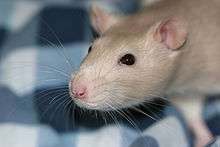
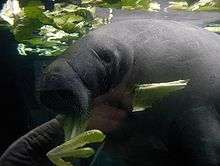


Whiskers or vibrissae (/vaɪˈbrɪsi/; singular: vibrissa; /vaɪˈbrɪsə/) are a type of mammalian hair that are typically characterised, anatomically, by their large length, large and well-innervated hair follicle, and by having an identifiable representation in the somatosensory cortex of the brain.[1]
They are specialised for tactile sensing (other types of hair operate as more crude tactile sensors). Vibrissae grow in various places on most mammals, including all primates except humans.[2]
In medicine, the term vibrissae also refers to the thick hairs found inside human nostrils.[3]
Anatomy
Vibrissal groups
Vibrissae (derived from the Latin "vibrio" meaning to vibrate) typically grow in groups in different locations on an animal. These groups are relatively well conserved across land mammals, and somewhat less well conserved between land and marine mammals (though commonalities are certainly present). Species-specific differences are also found. Vibrissae of different groups may vary in their anatomical parameters and in their operation, and it is generally assumed that they serve different purposes in accordance with their different locations on the body.
Many land mammals, for example rats[4] and hamsters,[5] have an arrangement of cranial (of the skull) vibrissae that includes the supraorbital (above the eyes), genal (of the cheeks), and mystacial (where a moustache would be) vibrissae, as well as mandibular (of the jaw) vibrissae under the snout.[6] These groups, all of which are visible in the accompanying image of the Patagonian fox, are well conserved across land mammals though anatomical and functional details vary with the animal's lifestyle.
Mystacial vibrissae are generally described as being further divided into two sub-groups: the large macrovibrissae that protrude to the sides and the small microvibrissae below the nostrils that mostly point downwards.[7] Most simply described, macrovibrissae are large, motile and used for spatial sensing, whereas microvibrissae are small, immotile and used for object identification. These two sub-groups can be identified in the accompanying image of the rat, but it can also be seen that there is no clear physical boundary between them. This difficulty in delineating the sub-groups visually is reflected by similarly weak boundaries between them in anatomical and functional parameters, though the distinction is nonetheless referred to ubiquitously in scientific literature and is considered useful in analysis.
Apart from cranial vibrissae, other groups are found elsewhere on the body. Many land mammals, including domestic cats, also have carpal (of the wrist) vibrissae on the underside of the leg just above the paws.[8] Whilst these five major groups (supraorbital, genal, mystacial, mandibular, carpal) are often reported in studies of land mammals, several other groups have been reported more occasionally (for instance, see [9]).
Marine mammals can have substantially different vibrissal arrangements. For instance, cetaceans have lost the vibrissae around the snout and gained vibrissae around their blowholes,[10] whereas every single one of the body hairs of the Florida manatee (see image) may be a vibrissa.[11] Other marine mammals (such as seals and sea-lions) have cranial vibrissal groups that appear to correspond closely to those described for land mammals (see the accompanying image of a seal), although these groups function quite differently.
Vibrissae
The vibrissal hair is usually thicker and stiffer than other types of (pelagic) hair[12] but, like other hairs, the shaft consists of an inert material (keratin) and contains no nerves.[12] However, vibrissae are different from other hair structures because they grow from a special hair follicle incorporating a capsule of blood called a blood sinus which is heavily innervated by sensory nerves.[13][14]
The mystacial macrovibrissae are shared by a large group of land and marine mammals (see images), and it is this group that has received by far the most scientific study. The arrangement of these whiskers is not random: they form an ordered grid of arcs (columns) and rows, with shorter whiskers at the front and longer whiskers at the rear (see images).[7] In the mouse, gerbil, hamster, rat, guinea pig, rabbit, and cat, each individual follicle is innervated by 100–200 primary afferent nerve cells.[13] These cells serve an even larger number of mechanoreceptors of at least eight distinct types.[14] Accordingly, even small deflections of the vibrissal hair can evoke a sensory response in the animal.[15] Rats and mice typically have approximately 30 macrovibrissae on each side of the face, with whisker lengths up to around 50 mm in (laboratory) rats, 30 mm in (laboratory) mice, and a slightly larger number of microvibrissae.[7] Thus, an estimate for the total number of sensory nerve cells serving the mystacial vibrissal array on the face of a rat or mouse might be 25,000.
Rats and mice are considered to be "whisker specialists", but marine mammals may make even greater investment in their vibrissal sensory system. Seal whiskers, which are similarly arrayed across the mystacial region, are each served by around 10 times as many nerve fibres as those in rats and mice, so that the total number of nerve cells innervating the mystacial vibrissae of a seal has been estimated to be in excess of 300,000.[16] Manatees, remarkably, have around 600 vibrissae on or around their lips.[10]
Whiskers can be very long in some species; the length of a chinchilla's whiskers can be more than a third of its body length (see image).[17] Even in species with shorter whiskers, they can be very prominent appendages (see images). Thus, whilst whiskers certainly could be described as "proximal sensors" in contrast to, say, eyes, they offer a tactile sense with a sensing range that is functionally very significant.
Operation
Movement
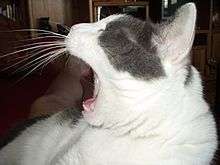
The follicles of some groups of vibrissae in some species are motile. Generally, the supraorbital, genal and macrovibrissae are motile,[5] whereas the microvibrissae are not. This is reflected in anatomical reports that have identified musculature associated with the macrovibrissae that is absent for the microvibrissae.[18] A small muscle 'sling' is attached to each macrovibrissa and can move it more-or-less independently of the others, whilst larger muscles in the surrounding tissue move many or all of the macrovibrissae together.[18][19]
Amongst those species with motile macrovibrissae, some (rats, mice, flying squirrels, gerbils, chincillas, hamsters, shrews, porcupines, opossums) move them back and forth periodically in a movement known as whisking,[20] while other species (cats, dogs, racoons, pandas) do not appear to.[1] The distribution of mechanoreceptor types in the whisker follicle differs between rats and cats, which may correspond to this difference in the way they are used.[14] Whisking movements are amongst the fastest produced by mammals.[21] In all whisking animals in which it has so far been measured, these whisking movements are rapidly controlled in response to behavioural and environmental conditions.[1] The whisking movements occur in bouts of variable duration, and at rates between 3 and 25 whisks/second. Movements of the whiskers are closely co-ordinated with those of the head and body.[1]
Function
Generally, vibrissae are considered to mediate a tactile sense, complementary to that of skin. This is presumed to be advantageous in particular to animals that cannot always rely on sight to navigate or to find food, for example, nocturnal animals or animals which forage in muddy waters. Sensory function aside, movements of the vibrissae may also indicate something of the state of mind of the animal,[22] and the whiskers play a role in social behaviour of rats.[23]
The sensory function of vibrissae is an active research area—experiments to establish the capabilities of whiskers use a variety of techniques, including temporary deprivation either of the whisker sense or of other senses. Animals can be deprived of their whisker sense for a period of weeks by whisker trimming (they soon grow back), or for the duration of an experimental trial by restraining the whiskers with a flexible cover like a mask (the latter technique is used, in particular, in studies of marine mammals[24]). Such experiments have shown that whiskers are required for, or contribute to: object localization,[25][26] orienting of the snout, detection of movement, texture discrimination, shape discrimination, exploration, thigmotaxis, locomotion, maintenance of equilibrium, maze learning, swimming, locating food pellets, locating food animals, and fighting, as well as nipple attachment and huddling in rat pups.[1]
Whisking—the periodic movement of the whiskers—is also presumed to serve tactile sensing in some way. However, exactly why an animal might be driven "to beat the night with sticks", as one researcher once put it,[27] is a matter of debate, and the answer is probably multi-faceted. Scholarpedia[1] offers:
"Since rapid movement of the vibrissae consumes energy, and has required the evolution of specialised musculature, it can be assumed that whisking must convey some sensory advantages to the animal. Likely benefits are that it provides more degrees of freedom for sensor positioning, that it allows the animal to sample a larger volume of space with a given density of whiskers, and that it allows control over the velocity with which the whiskers contact surfaces."
Animals that do not whisk, but have motile whiskers, presumably also gain some advantage from the investment in musculature. Dorothy Souza, in her book Look What Whiskers Can Do[28] reports some whisker movement during prey capture (in cats, in this case):
"Whiskers bend forward as the cat pounces. Teeth grasp the mouse tightly around its neck. The cat holds on until the prey stops wriggling."
Anecdotally, it is often stated that cats use their whiskers to gauge whether an opening is wide enough for their body to pass through.[29][30] This is sometimes supported by the statement that the whiskers of individual cats extend out to about the same width as the cat's body, but at least two informal reports indicate that whisker length is genetically determined and does not vary as the cat grows thinner or fatter.[22][31] In the laboratory, rats are able to accurately (within 5-10%) discriminate the size of an opening,[32] so it seems likely that cats can use their whiskers for this purpose. However, reports of cats, particularly kittens, with their heads firmly stuck in some discarded receptacle are commonplace[33] indicating that if a cat has this information available, it doesn't always make best use of it.
Marine mammals
Pinnipeds have well-developed tactile senses. Their mystacial vibrissae have ten times the innervation of terrestrial mammals, allowing them to effectively detect vibrations in the water.[34] These vibrations are generated, for example, when a fish swims through water. Detecting vibrations is useful when the animals are foraging and may add to or even replace vision, particularly in darkness.[35]

Harbor seals have been observed following varying paths of another seal that swam ahead several minutes before, similar to a dog following a scent trail,[24][36] and even to discriminate the species and the size of the fish responsible for the trail.[37] Blind ringed seals have even been observed successfully hunting on their own in Lake Saimaa, likely relying on their vibrissae to gain sensory information and catch prey.[38] Unlike terrestrial mammals, such as rodents, pinnipeds do not move their vibrissae over an object when examining it but instead extend their moveable whiskers and keep them in the same position.[35] By holding their vibrissae steady, pinnipeds are able to maximize their detection ability.[39] The vibrissae of seals are undulated and wavy while sea lion and walrus vibrissae are smooth.[40] Research is ongoing to determine the function, if any, of these shapes on detection ability. The vibrissa's angle relative to the flow, not the shape, however, seems to be the most important factor.[39]
Lines of research
Neuroscience
A large part of the brain of whisker-specialist mammals is involved in the processing of nerve impulses from vibrissae, a fact that presumably corresponds to the important position the sense occupies for the animal. Information from the vibrissae arrives in the brain via the trigeminal nerve and is delivered first into the trigeminal sensory complex of brainstem. From there, the most studied pathways are those leading up through parts of thalamus and into barrel cortex,[41] though other major pathways through the superior colliculus in midbrain (a major visual structure in visual animals) and the cerebellum, to name but a couple, are increasingly coming under scrutiny.[42] Neuroscientists, and other researchers, studying sensory systems favour the whisker system for a number of reasons (see Barrel cortex), not least the simple fact that laboratory rats and mice are whisker, rather than visual, specialists.
Evolutionary biology
The presence of mystacial vibrissae in distinct lineages (Rodentia, Afrotheria, marsupials) with remarkable conservation of operation suggests that they may be an old feature present in a common ancestor of all therian mammals.[43] Indeed, some humans even still develop vestigial vibrissal muscles in the upper lip,[44] consistent with the hypothesis that previous members of the human lineage had mystacial vibrissae. Thus, it is possible that the development of the whisker sensory system played an important role in mammalian development, more generally.[43]
Artificial whiskers
Researchers have begun to build artificial whiskers of a variety of types, both to help them understand how biological whiskers work and as a tactile sense for robots. These efforts range from the abstract,[45] through feature-specific models,[46][47] to attempts to reproduce complete whiskered animals in robot form (ScratchBot[48] and ShrewBot,[49][50][51] both robots by Bristol Robotics Laboratory). An upcoming article at Scholarpedia will discuss the history of whiskered Robots in detail.[52]
In non-mammalian animals
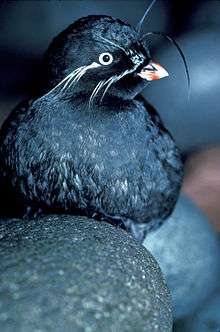
A range of non-mammalian animals possess structures which resemble or function similarly to mammalian whiskers.
In birds

Some birds possess specialized hair-like feathers called rictal bristles around the base of the beak which are sometimes referred to as whiskers.
The whiskered auklet (Aethia pygmaea) has striking, stiff white feathers protruding from above and below the eyes of the otherwise slate-grey bird, and a dark plume which swoops forward from the top of its head. Whiskered auklets sent through a maze of tunnels with their feathers taped back bumped their heads more than twice as often as they did when their feathers were free, indicating they use their feathers in a similar way to cats.[53]
Other birds that have obvious "whiskers" are flycatchers, swallows, nightjars, whip-poor-wills, the kakapo and the long-whiskered owlet (Xenoglaux loweryi).
In fish
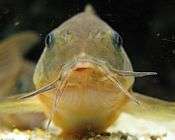
Some fish have slender, pendulous tactile organs near the mouth. These are often referred to as "whiskers", although they are more correctly termed barbels. Fish that have barbels include the catfish, carp, goatfish, hagfish, sturgeon, zebrafish and some species of shark.
The Pimelodidae are a family of catfishes (order Siluriformes) commonly known as the long-whiskered catfishes.
In pterosaurs
Anurognathid pterosaurs have a rugose (wrinkled) jaw texture that has been interpreted as the attachment sites for vibrissae,[54] though actual vibrissae have not been recorded.[55]
Gallery
- Directional sunlight highlights facial vibrissae of a cat.
.jpg) An otter with facial whiskers.
An otter with facial whiskers. Macrovibrissae of a Hooded Lister laboratory rat.
Macrovibrissae of a Hooded Lister laboratory rat. A cat's prominent macrovibrissae.
A cat's prominent macrovibrissae.- Micrograph cross section of an equine vibrissa.
 Macrovibrissae of a tiger.
Macrovibrissae of a tiger. Laboratory mouse (C57BL/6) showing macrovibrissae.
Laboratory mouse (C57BL/6) showing macrovibrissae. Prominent immotile vibrissae on a horse's muzzle.
Prominent immotile vibrissae on a horse's muzzle.- Supraorbital vibrissae and mystacial macrovibrissae of a house cat.
 Whiskers of the Brown Thrasher near the head.
Whiskers of the Brown Thrasher near the head.
References
- 1 2 3 4 5 6 Grant, Robyn; Mitchinson, Ben; Prescott, Tony (2011). "Vibrissal behaviour and function". Scholarpedia. 6 (10): 6642. doi:10.4249/scholarpedia.6642. Retrieved October 29, 2011.
- ↑ Van Horn, R.N. (1970). "Vibrissae Structure in the Rhesus Monkey". Folia Primatol. 13 (4): 241–285. doi:10.1159/000155325. PMID 5499675.
- ↑ "Vibrissae". The Free Dictionary's Medical dictionary. Farlex, Inc. April 14, 2009. Retrieved April 29, 2009.
- ↑ Vincent, S.B. (1913). "The tactile hair of the white rat". The Journal of Comparative Neurology. 23 (1): 1–34. doi:10.1002/cne.900230101.
- 1 2 Wineski, Lawrence E. (1983). "Movements of the cranial vibrissae in the Golden hamster (Mesocricetus auratus)". Journal of Zoology. 200 (2): 261–280. doi:10.1111/j.1469-7998.1983.tb05788.x.
- ↑ "Structure, function, and cortical representation of the rat submandibular whisker trident". The Journal of Neuroscience. 33 (11): 4815–4824. 2013. doi:10.1523/jneurosci.4770-12.2013.
- 1 2 3 Brecht, Michael; Preilowski, Bruno; Merzenich, Michael M. (1997). "Functional architecture of the mystacial vibrissae". Behavioural Brain Research. 84: 81–97. doi:10.1016/S0166-4328(97)83328-1.
- ↑ Beddard, Frank E. (1902). "Observations upon the carpal vibrissae in mammals". Journal of Zoology. 72 (1): 127–136. doi:10.1111/j.1469-7998.1902.tb08213.x.
- ↑ "A new vibrissa group in insectivores (Mammalia, Insectivora) and its role in orientation". Doklady Biological Sciences. 438 (1): 154–157. 2011. doi:10.1134/s0012496611030021.
- 1 2 "Whiskers! A Feel For The Dark".
- ↑ "Tactile Hairs on the Postcranial Body in Florida Manatees: A Mammalian Lateral Line?". Brain, Behaviour and Evolution. 59: 141–154. doi:10.1159/000064161.
- 1 2 Weldon Owen Pty Ltd. (1993). Encyclopedia of animals - Mammals, Birds, Reptiles, Amphibians. Reader's Digest Association, Inc. pg. 18. ISBN 1-875137-49-1.
- 1 2 Rice, Frank L.; Mance, Ajuan; Munger, Bryce L. (8 October 1986). "A comparative light microscopic analysis of the sensory innervation of the mystacial pad. I. Innervation of vibrissal follicle-sinus complexes". The Journal of Comparative Neurology. 252 (2): 154–174. doi:10.1002/cne.902520203. PMID 3782505.
- 1 2 3 Ebara, Satomi; Kumamoto, Kenzo; Matsuura, Tadao; Mazurkiewicz, Joseph E.; Rice, Frank L. (22 July 2002). "Similarities and differences in the innervation of mystacial vibrissal follicle–sinus complexes in the rat and cat: A confocal microscopic study". The Journal of Comparative Neurology. 449 (2): 103–119. doi:10.1002/cne.10277. PMID 12115682.
- ↑ Stuttgen, M. C.; Rüter, J; Schwarz, C (July 26, 2006). "Two Psychophysical Channels of Whisker Deflection in Rats Align with Two Neuronal Classes of Primary Afferents". The Journal of Neuroscience. 26 (30): 7933–7941. doi:10.1523/JNEUROSCI.1864-06.2006. PMID 16870738.
- ↑ "Microstructure and innervation of the mystacial vibrissal follicle sinus complex in bearded seals, Erignathus barbatus (Pinnipedia: Phocidae).". The Anatomical Record Part A: Discoveries in Molecular, Cellular, and Evolutionary Biology. 288 (1): 13–25. January 2006. doi:10.1002/ar.a.20273. PMID 16342212.
- ↑ Spotorno, Angel E.; Zuleta, Carlos A.; Valladares, J. Pablo; Deane, Amy L.; Jiménez, Jaime E. (15 December 2004). "Chinchilla Laniger". Mammalian Species. The American Society of Mammalogists. 758: 1–9. doi:10.1644/758.
- 1 2 "The musculature of the mystacial vibrissae of the white mouse". J Anat. 135 (Pt 1): 147–54. 1982. PMC 1168137
 . PMID 7130049.
. PMID 7130049. - ↑ "Biomechanics of the Vibrissa Motor Plant in Rat: Rhythmic Whisking Consists of Triphasic Neuromuscular Activity". The Journal of Neuroscience. 28: 3438–3455. doi:10.1523/JNEUROSCI.5008-07.2008.
- ↑ "Video of rat whisking". Youtube.com. Retrieved 2013-06-24.
- ↑ Jin, T.-E.; Witzemann, V; Brecht, M (March 31, 2004). "Fiber Types of the Intrinsic Whisker Muscle and Whisking Behavior". The Journal of Neuroscience. 24 (13): 3386–3393. doi:10.1523/JNEUROSCI.5151-03.2004. PMID 15056718.
- 1 2 "Just the cat's whiskers".
- 1 2 Dehnhardt, G. (2001). "Hydrodynamic trail-following in harbor seals (Phoca vitulina)". Science. 293 (5527): 102–104. doi:10.1126/science.1060514. PMID 11441183.
- ↑ Ahissar, E; Knutsen, PM. "Vibrissal location decoding". Scholarpedia. 6 (10): 6639. doi:10.4249/scholarpedia.6639.
- ↑ Diamond, M; von Heimendahl, P; Knutsen, P; Kleinfeld, D; Ahissar, A. "'Where' and 'what' in the whisker sensorimotor system". Nat Rev Neurosci. 9 (8): 601–612. doi:10.1038/nrn2411.
- ↑ Brecht, Michael (September 2004). "What Makes Whiskers Shake?". Journal of Neurophysiology. 92 (3): 1265–1266. doi:10.1152/jn.00404.2004.
- ↑ "Look What Whiskers Can Do". Lerner Publishing Group.
- ↑ "Why Do Cats Have Whiskers?". Vetinfo.com. Retrieved 2013-06-24.
- ↑ "Cat Behaviour Explained". Cat-behavior-explained.com. 2013-04-03. Retrieved 2013-06-24.
- ↑ "Focus Magazine Q&A".
- ↑ "Behavioral Properties of the trigeminal somatosensory system in rats performing whisker-dependent tactile discriminations". The Journal of Neuroscience. 21 (15): 5752–5763.
- ↑ "Cops save kitten with head stuck in can". Torontosun.com. 2011-01-25. Retrieved 2013-06-24.
- ↑ Schusterman, R. J.; Kastak, D.; Levenson, D. H.; Reichmuth, C. J.; Southall, B. L. (2000). "Why pinnipeds don't echolocate". The Journal of the Acoustical Society of America. 107 (4): 2256–64. doi:10.1121/1.428506. PMID 10790051.
- 1 2 Miersch, L.; Hanke, W.; Wieskotten, S.; Hanke, F. D.; Oeffner, J.; Leder, A.; Brede, M.; Witte, M.; Dehnhardt, G. (2011). "Flow sensing by pinniped whiskers". Philosophical Transactions of the Royal Society B: Biological Sciences. 366 (1581): 3077–84. doi:10.1098/rstb.2011.0155. PMC 3172597
 . PMID 21969689.
. PMID 21969689. - ↑ Schulte-Pelkum, N.; Wieskotten, S.; Hanke, W.; Dehnhardt, G. & Mauck, B. (2007). "Tracking of biogenic hydrodynamic trails in harbour seals (Phoca vitulina)". Journal of Experimental Biology. 210: 781–787. doi:10.1242/jeb.02708. PMID 17297138.
- ↑ Grant R, Wieskotten S, Wengst N, Prescott T, Dehnhardt G (2013). "Vibrissal touch sensing in the harbor seal (Phoca vitulina): how do seals judge size?". Journal of Comparative Physiology A. 199: 521–531. doi:10.1007/s00359-013-0797-7.
- ↑ Hyvärinen H. (1989). "Diving in darkness: whiskers as sense organs of the ringed seal (Phoca hispida saimensis)". Journal of Zoology. 218 (4): 663–678. doi:10.1111/j.1469-7998.1989.tb05008.x.
- 1 2 Murphy, T.C.; Eberhardt, W.C.; Calhoun, B.H.; Mann, K.A.; Mann, D.A. (2013). "Effect of Angle on Flow-Induced Vibrations of Pinniped Vibrissae". PLoS ONE. 8 (7): e69872. doi:10.1371/journal.pone.0069872.
- ↑ Ginter CC & Fish FE (2010). "Morphological analysis of the bumpy profile of phocid vibrissae.". Marine Mammal Science. 26: 733–743. doi:10.1111/j.1748-7692.2009.00365.x.
- ↑ Deschenes, Martin (2009). "Vibrissal afferents from trigeminus to cortices". Martin Deschenes and Nadia Urbain (2009), Scholarpedia. 4 (5): 7454. doi:10.4249/scholarpedia.7454.
- ↑ Kleinfeld, Rune w. Berg (1999). "Anatomical loops and their electrical dynamics in relation to whisking by rat". Somatosensory & Motor Research. 16 (2): 69–88. doi:10.1080/08990229970528.
- 1 2 Mitchinson, B.; Grant, R. A.; Arkley, K.; Rankov, V.; Perkon, I.; Prescott, T. J. (12 November 2011). "Active vibrissal sensing in rodents and marsupials". Phil. Trans. R. Soc. B. 366 (1581): 3037–3048. doi:10.1098/rstb.2011.0156. PMC 3172598
 . PMID 21969685.
. PMID 21969685. - ↑ Tamatsu, Yuichi; Tsukahara, Kazue; Hotta, Mitsuyuki; Shimada, Kazuyuki (August 2007). "Vestiges of vibrissal capsular muscles exist in the human upper lip". Clin Anat. 20 (6): 628–31. doi:10.1002/ca.20497. PMID 17458869.
- ↑ "Invention: Artificial whiskers".
- ↑ Costandi, Mo (2006-10-05). "Sculpted Face". Neurophilosophy.wordpress.com. Retrieved 2013-06-24.
- ↑ "AMouse". CiteSeerX 10.1.1.58.6535
 .
. - ↑ "Bristol Robotics Lab - Scratchbot". YouTube. 2009-07-01. Retrieved 2013-06-24.
- ↑ "SCRATCHbot - A Rat like Robot". YouTube. 2011-09-15. Retrieved 2013-06-24.
- ↑ "Whiskerbot". YouTube. 2011-09-03. Retrieved 2013-06-24.
- ↑ "A robot inspired by the Etruscan shrew called Shrewbot". YouTube. 2012-01-19. Retrieved 2013-06-24.
- ↑ Whiskered robots - Scholarpedia
- ↑ Brown, S. (2008). "Bird uses 'whiskers' like a cat". Nature. Retrieved September 28, 2013.
- ↑ Bennett et al 2007b
- ↑ Wilton, Mark P. (2013). Pterosaurs: Natural History, Evolution, Anatomy. Princeton University Press. ISBN 0691150613.
External links
- A night in the life of a rat, Annals of the New York Academy of Sciences, 1225:110–118, April 2011.
- The Mysterious Whiskers of Cats, Blog-post about the functions of cat whiskers, April 7, 2012.
| Wikimedia Commons has media related to Vibrissae. |